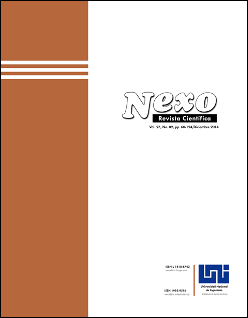Simulation of a continuous plug-flow fluidised bed dryer for rough rice
DOI:
https://doi.org/10.5377/nexo.v27i2.1947Keywords:
Plug-flow, Fluidised bed dryer, Modelling, Rough riceAbstract
In this study, a mathematical model to simulate the drying of rough rice in a continuous plug-flow fluidised bed dryer ispresented. Equipment and material models were applied to describe the process. The equipment model was based on thedifferential equations obtained by applying mass and energy balances to each element of the dryer. Concerning the materialmodel, mass and heat transfer rates in a single isolated particle were considered. Mass and heat transfer within the particles wasdescribed by analytical solutions with constant effective transport coefficients. To simulate the dryer, the material model wasimplemented in the equipment model in order to describe the whole process. Calculation results were verified by comparisonwith experimental data from the literature. There was very good agreement between experimental data and simulation. Theeffects of gas temperature and velocity, particle diameter, dry solid flow and solid temperature on the drying process wereinvestigated. It was found that the changes in gas velocity, dry solids flow and solid temperature had essentially no effect ondrying behaviour.
Downloads
3181
Downloads
Published
How to Cite
Issue
Section
License
The authors who publish in Nexo Scientific Journal agree to the following terms:
- Authors retain the copyright and grant the journal the right of the first publication under the license Creative Commons Attribution License, which allows others to share the work with a recognition of the authorship of the work and the initial publication in Nexo Scientific Journal.
- Authors may separately establish additional agreements for the non-exclusive distribution of the version of the work published in the journal (for example, in an institutional repository or a book), with the recognition of the initial publication in Nexo Scientific Journal.
- Authors are allowed and encouraged to disseminate their works electronically (for example, in institutional repositories or in their own website) before and during the submission process, as it can lead to productive exchanges, as well as earlier and greater citation of published works.










